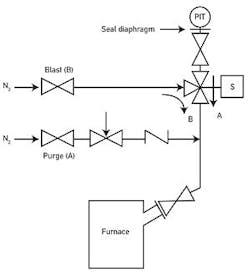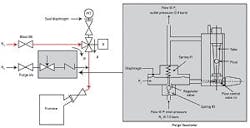This column is moderated by Béla Lipták, automation and safety consultant, who is also the editor of the Instrument and Automation Engineers' Handbook (IAEH). If you would like to become a contributing author of the 5th edition or if you have an automation related question for this column, write to [email protected]
So why did I select the simple question below? Because that question represents reality out in the field. IT and algorithm wizards can develop the smartest devices or protocols, but if the information they work with is bad, it will do no good. The key law of control design is "Garbage in, garbage out!"
Q: We're measuring the pressure in a furnace as shown in Figure 1. Should the blast pressure be more than purging pressure? Is this right?
If the figure is right, why use a purging line? Could we just use blast pressure all the time?
Assuming that we have the same 7kg/cm2 N2 pressure supply for both purging and blast input, and the furnace pressure is 3.5kg/cm2, why could we not just use the blast pressure all the time? If we did that, would the pressure transmitter show 3.5kg/cm2 or not? If not, why?
Figure 1. A reader wants to know why, given the design above, both a purge and a blast line are needed.
So if the pressure transmitter is showing 3.5kg/cm2, then why is the purging line required? Is the purging line and blast line difference only related to consumption of N2 ?Ashish GargA: The purge and the blast lines serve two different functions. The purpose of the "purge flow" is to make sure that the line between the furnace and the pressure transmitter is filled with clean and cold nitrogen. This can and should be achieved by continuously introducing a small flow of purge nitrogen into the furnace.
The purpose of the "blast flow" is different! It's purpose is to periodically blast a large flow of nitrogen though the connecting line to the furnace, and thereby blow out any plugging or any material that is beginning to build up between the furnace and the three-way solenoid that isolates the pressure transmitter from the nitrogen flow during blasting.
So what is wrong with your present system? Two things:
- The purge flow is not controlled at a low flow rate, and
- The connecting line to the furnace is probably too small.
What is the consequence of this? The consequence is that the pressure detected by the pressure transmitter is the sum of the furnace pressure plus the pressure drop of the purge flow in the connecting line (probably 0.25 in. diameter) as it travels through the small diameter tube before it enters the furnace. This results in inaccurate pressure measurement.
(click here to image to enlarge)
Figure 2. Eliminate the needle valve and the check valve in the purge line, and replace them with a purge flowmeter (see right-hand side of diagram), and increase the diameter of the pipe carrying the blast flow (red lines on the left.)
- In the purge line, you should eliminate the needle valve and the check valve, and replace them with a purge flowmeter, as shown on the right side of the figure, and
- Increase the diameter of the pipe, which carries the blast flow into the furnace to a larger one (0.5 in. or larger), so that the pressure drop will be negligible through it during purging. In Figure 2, I have identified the pipe section which should be made larger in diameter with red coloring.
A: The first thing I used to do when facing an unsolvable problem was to accept the fact that something you think you know is true is, in fact, not true. The first thing I would do is to remove the purge supply pressure regulator. Or, if it is required for some other reason, install an ordinary pressure regulator set as high as you can, considering the system design. As designed, any occasional upset in stack pressure will push stack materials back into the pressure connection before the regulator can respond. This gradually will obstruct the end of the pipe.
The purge flow should be set by the needle valve, and it should have as much pressure drop across it as possible. If you have most of the purge pressure drop across the needle valve, it will behave as a constant flow device even as the stack pressure changes. This would be like a constant current electrical source.
You do not show the sizes of the piping between the purge system and the stack. It has to be large enough so that the measured pressure does not change with changes in the purge flow. Even if the purge seems to flow freely, there is always the chance of a restriction severe enough to show up when you do your "blast." I would see if it is possible to remove and inspect that piping at the next available opportunity. I suspect the problem is an obstruction in the piping. Perhaps you can work around that. Maybe use new piping and an alternative connection to the stack.
A: If a purge rotameter is indicating flow, that means purging is working, and differential pressure across the rotameter is positive. Furnace pressure normally is maintained negative, so that fire does not come back. Purge rotameters come in a standard range, and any standard manufacturer should be acceptable.
Furnace pressure is normally maintained a few mm H2O negative. Normally a very low-range transmitter should be used, and if the same transmitter is facing 7 bar, there could be permanent damage to the pressure transmitter.
Also, the SOV exhaust port is connected to the pressure source. This is possible only if the SOV is the universal type. Normal SOVs will not function when exhaust is connected to the pressure point.
About the Author
Béla Lipták
Columnist and Control Consultant
Béla Lipták is an automation and safety consultant and editor of the Instrument and Automation Engineers’ Handbook (IAEH).

Leaders relevant to this article:



